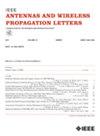基于非线性互耦合模型的精确参数解析流形
IF 4.8
2区 计算机科学
Q2 ENGINEERING, ELECTRICAL & ELECTRONIC
引用次数: 0
摘要
精确的互耦合模型是获得精确的参数解析流形的关键,是实现超分辨到达方向估计和高精度波束形成的前提。目前广泛使用的互耦模型是线性的,不能描述互耦的方向依赖特性,导致阵列信号处理算法的性能严重下降。本文基于泰勒展开,建立了一种新的非线性互耦模型——高阶宽互耦矩阵(MCM)来描述相邻两个天线单元之间的方向依赖耦合关系。然后,利用天线方向图重构方法,利用高阶广义MCM的有限阶近似得到精确的参数解析流形。数值算例验证了所提出的参数解析流形能成倍地减小阵列流形重构误差。特别是采用分段拟合策略时,可将四阶近似解析流形的重构误差降低到传统阵列流形的1%以下。本文章由计算机程序翻译,如有差异,请以英文原文为准。
Accurate Parametric Analytic Manifold Using a Nonlinear Mutual Coupling Model
The precise mutual coupling model is the key to obtain an accurate parametric analytic manifold, which is the prerequisite to achieve superresolution direction of arrival estimation and high-precision beamforming. The widely used mutual coupling model is linear and cannot describe the direction-dependent characteristics of mutual coupling, which leads to serious performance deterioration of array signal processing algorithms. In this letter, a new nonlinear mutual coupling model named high-order broad mutual coupling matrix (MCM) is established based on the Taylor expansion to describe the directional-dependent coupling relationship between two adjacent antenna elements. Then, an accurate parametric analytic manifold using a finite-order approximation of the high-order broad MCM is yielded by the antenna pattern reconstruction method. Numerical examples verify that the array manifold reconstruction errors can be reduced exponentially by the proposed parametric analytic manifold. Especially when the piecewise fitting strategy is adopted, the reconstruction errors of the fourth-order approximated analytic manifold can be reduced to less than 1% of those of the conventional array manifold.
求助全文
通过发布文献求助,成功后即可免费获取论文全文。
去求助
来源期刊
CiteScore
8.00
自引率
9.50%
发文量
529
审稿时长
1.0 months
期刊介绍:
IEEE Antennas and Wireless Propagation Letters (AWP Letters) is devoted to the rapid electronic publication of short manuscripts in the technical areas of Antennas and Wireless Propagation. These are areas of competence for the IEEE Antennas and Propagation Society (AP-S). AWPL aims to be one of the "fastest" journals among IEEE publications. This means that for papers that are eventually accepted, it is intended that an author may expect his or her paper to appear in IEEE Xplore, on average, around two months after submission.

 求助内容:
求助内容: 应助结果提醒方式:
应助结果提醒方式:


